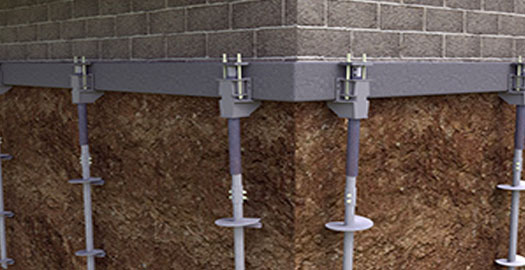
Have you noticed cracks in your residential, commercial or industrial building’s walls or sloping along your floors? The soil under your foundation may be to blame. If significant settlement on moderate differential settlement occurs foundation underpinnings may be required. Thankfully, there are ways to fix a cracking or deteriorating foundation, even if your building has already settled. The solution involves using one or more underpinning techniques.
Pit/Pad Underpinning
Pit or pad underpinning is the process of reinforcing foundations or increasing the depth of a building’s foundation by excavating underneath the existing building and pouring concrete into the pit. Several inches are typically left between the new pad and the existing structure. The rest of the space is then filled with Non-Shrink Grout. Pit or pad underpinning is typically performed when the existing foundation is deemed unstable or nearby construction and excavation could disturb the existing building’s soil or undermine the footing.
Helical Piles
Helical Piles, also called helical screw piles or anchors, are large steel shafts with screw-like appendages called helical flights. This foundation stabilizing device is screwed into the soil until it reaches a predetermined depth or torque that is based on soil conditions and load factors. The tops of the shafts are then connected to the building’s footings to prevent the foundation from settling into the soil. These can be installed after a building has been constructed or on a new building.
Push Piles
Push piles are used for temporary foundation repair in buildings where the foundation is sinking. Additional names include resistance piers, jacked piles and steel piers. Push piles are connected to the footings on the outside wall of the commercial, residential or industrial building. They generally consist of a jack, steel pipe and screw-like end. Once connected to the footing, they are driven deep into the soil. The jack is used to raise and level the building to eliminate cracks and other structural problems. Since push piles are sometimes designed to be a temporary fix, additional permanent foundation stabilization techniques are needed after the building is level.
Grouted Column Piles
Grouted column piles or driven piles are either preformed and driven into the ground using heavy machinery, or they are poured in place. These piles can add structural stability in areas where the soil is exceptionally sandy, silty or loose and prone to shifting or settling under a load or when vibrated. Grouted column piles are designed to provide protection against lateral loads, uplift and soil settlement. They are considered an environmentally friendly and economically friendly way of reinforcing foundations.
Mini and Micro Piles
Mini and micropiles can be designed to support loads up to 1,000 tons. They consist of a steel shell or casing and inner metal bar. They are typically driven through the footing to a predetermined depth. Once in place, the steel shell or casing is filled with cement grout in order to provide the additional structural support needed to stop the building from settling.
